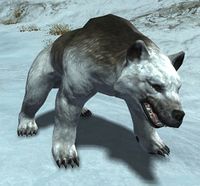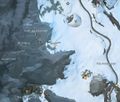Juvenile Arctodus
From Guild Wars 2 Wiki
Jump to navigationJump to search
“The arctodus is a mighty snow wolf-bear. Its wolf side gives it a strong pack mentality that makes it very protective of its companions. It can roar with arctic might, chilling opponents to the core and making it harder for them to move or act.
— Acht
Juvenile Arctoduses are amphibious pets that can be charmed by rangers.
Pet skills and attributes[edit]
Arctodus pets use the following skills:
| Juvenile Arctodus skills | |||
|---|---|---|---|
| Skill type | Key | Skill | Description |
| Bear AI skills | Slash | Slash your foe with your claws. | |
| Bite | Bite your foe to recover health. | ||
| Defy Pain | You take no damage for the next few seconds. | ||
| Pet skill | F2 | Rending Maul | Beast. Make your foe bleed with a fierce mauling. |
Soulbeast merged skills |
F1 | Bite | Bite your foe to recover health. |
| F2 | Defy Pain | You receive no damage from incoming attacks. You remain susceptible to conditions and controlling effects. | |
| F3 | Worldly Impact | Beast. Jump up and slam the ground beneath you, severely damaging nearby foes. | |
At level 80, juvenile arctodus pets have the following default attributes:
| Attribute | Value |
|---|---|
| Power | 1,524 |
| Precision | 1,524 |
| Toughness | 2,211 |
| Vitality | 4,959 |
| Condition Damage | 400 |
| Ferocity | 0 |
| Healing Power | 1,200 |
Locations[edit]
- Wayfarer Foothills
- Frusenfell Creek — In a cave across the creek, east and slightly south of the Vendrake's Homestead Waypoint
- Moleberia — In a building behind a Veteran Dredge Exterminator in the north of the cave. Kill the dredge to open the gate
- Lornar's Pass
- Nentor Valley — Near the Ravenbeak Shrine PoI
- The Thunderhorns — Near entrance to Icedevil's Needle
- Frostgorge Sound
- Dimotiki Waters — Southwest at the coast
- Stonesledge Draft — on the icy shoreline directly west of Twoloop Waypoint
Interactive map[edit]
Gallery[edit]
- Alternate appearances
- Maps
Trivia[edit]
- Arctodus is an extinct genus of bear that lived during the Pleistocene epoch. They inhabited North America and died out about 11,000 years ago. Two species are known; Arctodus simus and Arctodus pristinus. In real life, Arctodus differed from the in-game version by having an unusually short snout for a bear. The short snout gives them the common names "short-faced bear" and "bulldog bear".
- Appearance-wise it bears a strong similarity to another extinct sub-family of bear called Hemicyoninae often called "dog-bears" that lived during the Oligocene through Miocene epochs.






